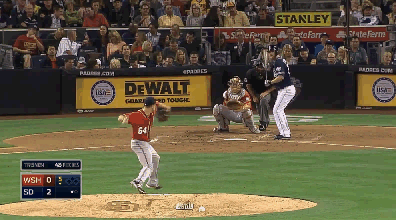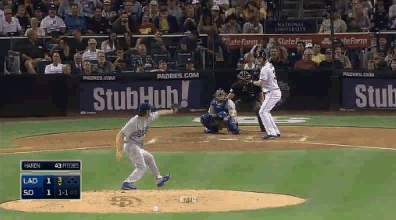The Unexpected Leader in Trying to Bunt for a Hit
It’s never easy to try to figure out intent after the fact. Consider questionable hit-by-pitches. Some of them are more obviously intentional than others, but there’s nothing we can do in a database to separate the intentionals from the accidentals. It gets a little tricky with bunting for a hit, too, because bunting can also serve a very different purpose, but there’s one thing we can look at as a proxy. Let’s focus only on bunt attempts with nobody on base. Sometimes, a hitter might be trying to bunt for a hit with somebody on, but that’s relatively uncommon, and when the bases are empty, at least we know with absolute certainty the idea. A bunt with no one on is a bunt attempt for a hit. Or it’s a bunt attempt by a guy inexplicably playing through a strained oblique, but, generally, it’s a bunt attempt for a hit.
So, 2014. Let’s use some data from Baseball Savant, combining bunts in play with foul and missed bunts, to come up with total attempts. Here’s something that won’t surprise you: Billy Hamilton led baseball with 77 bunt attempts with the bases empty. We can think of those as 77 bunt attempts for a hit. In second place, again unsurprisingly, we find Dee Gordon, with 70 attempts. Then there’s Leonys Martin, with 52, and Adeiny Hechavarria, with 40. All makes perfect sense. This only gets weird when you consider rate stats.
The rate stat of choice: bunt attempts over total pitches, with the bases empty. For example, take those 77 Hamilton attempts. With no one on, he faced 1,631 pitches, so he gets a rate of 4.7% — 4.7% of the time, with no one on, Hamilton tried to bunt last season. Some other example rates:
- Dee Gordon: 4.2%
- Leonys Martin: 4.1%
- Adeiny Hechavarria: 3.7%
- Jordan Schafer: 4.5%
- Ezequiel Carrera: 5.6%
- Danny Espinosa: 3.5%
No position player had a higher rate last year than Carrera, setting a minimum of ten attempts. He’s a speedy, slap-hitting sort, hence ten attempts out of 180 pitches. You might’ve noticed that I specifically referred to position players in that sentence. The reason is Andrew Cashner.
Cashner plays a position, and that position is pitcher. Pitchers bat, in the National League, so Cashner batted, and when Cashner batted with the bases empty, he faced 79 total pitches. Against those 79 total pitches, Cashner attempted to bunt for a hit 11 times. That gives him a rate of 13.9%.
Maybe that didn’t drive the point home. This’ll do it. The leaderboard, again, with a ten-attempt minimum:
- Andrew Cashner: 13.9%
- Ezequiel Carrera: 5.6%
- Billy Hamilton: 4.7%
Cashner topped second place by 148%. He posted three times Hamilton’s rate, and Billy Hamilton is Billy Hamilton. Now, here’s the reality of it: eight of Cashner’s attempts failed, in that they were missed or fouled. But we’re measuring attempts, not successes, and it’s pretty clear Cashner considers this a viable weapon.
Which isn’t news to the Padres. It might just be news to you. Cashner dominates the spring-training bunting competition. Consider:
Andrew Cashner won the bunting game #walkoff #funinthesun #padres
— Shane Stoddard (@stodpod5) February 26, 2014
Here’s a video in which Cashner talks about bunting with an unprofessional man:
Quote:
I take a lot of pride in bunting.
This article from March features a picture of Cashner bunting, with the caption beginning: “Bunting is not just a sacrificial act for Padres pitcher Andrew Cashner.” Just look at what happened in 2013. Cashner registered four bunt singles, including one with men on base. With no one on, Cashner faced 137 pitches, and he attempted to bunt eight times, for a rate of 5.8%. That’s nowhere close to where Cashner finished in 2014, but it’s still higher than Carrera’s rate. Cashner is extremely bunt-happy, because he has relatively good speed and relatively good bat control, and because he bats only infrequently, it doesn’t draw him too much attention. No one prepares an Andrew-Cashner-is-going-to-hit-against-us scouting report. I mean, probably. They shouldn’t.
These are a couple failed push-bunt attempts from the season:
Fine ideas. Just didn’t work — Cashner didn’t bunt the ball hard enough. A bunt single, against Dan Haren:
Here’s the funny thing about that. From 2013: a bunt single, against Dan Haren.
Cashner isn’t the only pitcher willing to try to bunt his way aboard. Teammate Tyson Ross has tried it a few times. On the Reds, both Johnny Cueto and Tony Cingrani have posted high bunt-attempt rates over the past two years, suggesting that there’s some clubhouse encouragement taking place. Cingrani, this year, actually finished with a slightly higher rate than Cashner did, but he fell short of the attempt minimum. Still, he’s one to watch.
But Cashner gets the spotlight. And as it happens, he’s incredibly well-rounded, as pitchers go. He’s been used by the Padres as a pinch-hitter. He’s been used by the Padres as a pinch-runner. He’s hit a home run. he’s hit a triple. He’s stolen a couple of bases. Andrew Cashner has done pretty much everything, including post an ERA under 3. That’s the most important thing for his job.
The rest? Gravy. Interesting, unusual gravy. What Cashner does away from the mound isn’t the reason why the Padres are so fond of him, but it’s among the reasons I’m so fond of him, and my feelings count, too. They don’t make ’em like Andrew Cashner. Baseball is better for his continued existence and health.
Jeff made Lookout Landing a thing, but he does not still write there about the Mariners. He does write here, sometimes about the Mariners, but usually not.




If Anthony Gose wants to stick in the major leagues, he will need to add this to his arsenal.